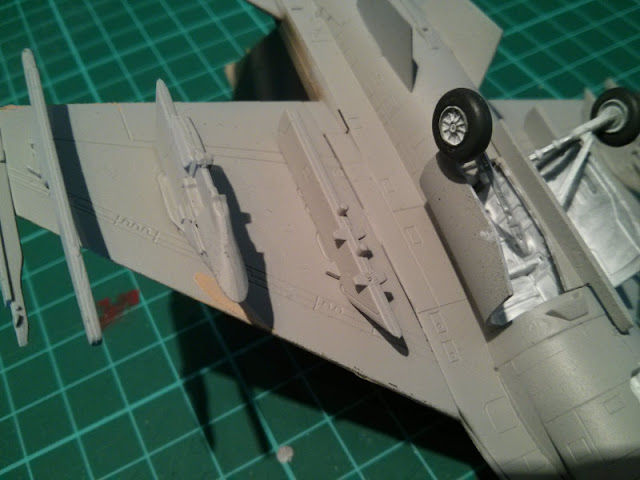Washes
All the camo-painted surfaces I washed with Vallejo's Model Wash for grey & dark vehicles (76516). The remaining grey parts I then washed with their Model Wash for light colors (76513). Previously I had already applied a bit of my beyond ancient (bought in the very late '90s) Citadel's Blue Glaze, which is still alive and working. The effect is very subtle, if even noticeable. Then again, you could say the same about the tips of the rockets in this scale, so I didn't bother worrying about it.
[135]
Clearcoat
The trickery department's tip of the Project was as follows: first the clearcoat, then the decals, finally the dullcoat. This was supposed to eliminate the ever so annoying silvering effect completely and help with who knows what else. If I did my weatherings more variedly than what I do, there'd be multiple coatings between each step.
Big boys have been yelling around the world that "
this is the only way to do things, you hear?", I thought I'll give it a shot. First I applied a clearcoat (Vallejo Gloss Varnish (70510)) on the model, so it and the washes would be protected from the water, if nothing else. This would've been a good idea with the proto-hog already.
First thing in the next morning I took a look at how my model looked like and I was a bit disturbed with the glossiness. In the best case everything would be different the next morning, but still. Well, someone had to be the guinea pig and the wheel of misfortune stopped on the Falcon.
 |
| Oh myyy... |
[140]
I still hate decals
My preparation for the decal part of the project was traditional. I threw all hope from the window and assumed that the model would follow very soon after. I decided to trust the mumblings in the net that claimed that the silvering would indeed not be a problem, so I didn't cut them off as paranoidly as I have previously done. Otherwise you couldn't - maybe - tell the difference between this method and my traditional approach.
Awesome. The second decal (between the canopy and the refueling slot signs) got bent and slightly tangled thanks to its annoying zigzag-shape. With a bit of swearing and frustration I got it straightened up somehow and soldiered on.
None of the other "
NO STEP" signs gave me no problems, as long as we ignore that I put one of them (the rear one of the right wing) facing the wrong direction. Of course noticed way too late to fix it. There was nothing going on to the bottom, except a strange four-part red line behind the extra wing-thingies. Then the drop tanks got two red dots and two markings I assumed to be for some "
lift here" info. Of those I ruined both of the ones going to the middle of the drop tank, they just went all spaghetti on me and I just couldn't salvage them no matter what.
This decal sheet had no 'murican roundels, just a couple of Belgian ones. I had no use for them, so I let it be with this thought "
it's a make-believe enemy, so it'll be a flying green man".
[170]
Dullcoat
Applying Vallejo Matt Varnish (70520) was my last item on the list. Before that I dabbed the model carefully with a cloth to remove any potential water residue. Then I started brushing on the coating. I started on the bottom, from the rear of the plane, going from the center outwards. This way I could hold onto the tail fin and keep the model nicely supported while working on it and the weird angles.
When done, I flipped the model around on its tyres and kept applying, still holding onto the fin for support. Now my brushing approach was the opposite: from nose to tail, from outer edges inward (to make sure that the tail fin was the last one to be processed).
In the middle of all this I noticed that the varnish had started to dry on the forward areas and I got really excited because the plane started to look just like the interwebs folks had claimed! It's almost shocking that there's some forum stuff that actually is true.
I took a couple of photos the next morning to see how things were going. It wasn't looking bad at all. The trickery department didn't fail but was actually useful. Yay! I could even go as far as declaring that the 'mumblings approve of this method.
[180]

















































